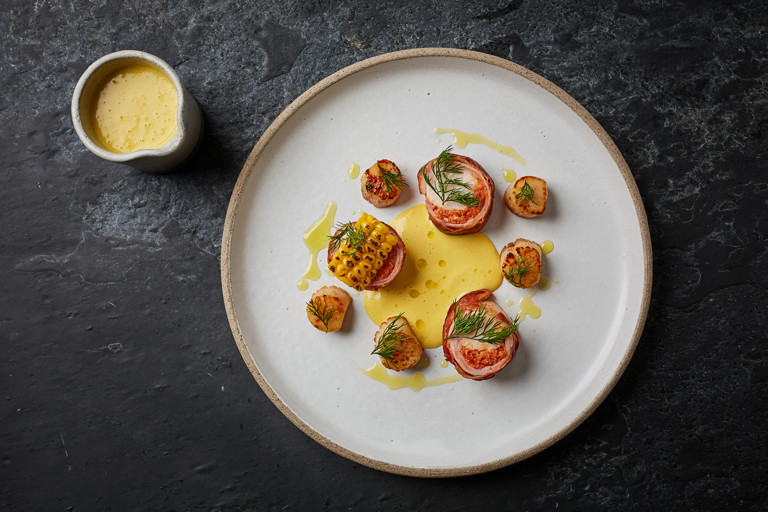Chorizo-stuffed rabbit saddle with scallops and chilled sweetcorn sauce
- medium
- 4
- 1 hour 30 minutes plus 2 hours chilling time
Rabbit can often be quite a dry meat, but rolling the loin in pancetta and stuffing it with Spanish chorizo ensures a delicious, rich little morsel which pairs perfectly with sweet scallops. The chilled sweetcorn sauce doesn't just look good – it complements the other flavours on the plate wonderfully.
Ingredients
Metric
Imperial
Rabbit
Scallops
- 12 large scallops, or 20 smaller ones
- 2 tsp rapeseed oil
- 2 knobs of butter
- sea salt
Sweetcorn
- 250g of sweetcorn kernels, (tinned), drained
- 50ml of double cream
- 100ml of chicken stock
- 1 fresh corn on the cob, ideally in its husk
- 1 tsp rapeseed oil
Method
Begin by adding 2 tablespoons of rapeseed oil into a pan and gently sweat off the onion until soft without colour. Remove from the pan and leave to cool
- rapeseed oil, for frying
- 1/4 onion, finely sliced
Meanwhile, prep the rabbit saddles. Remove the 2 loins from each saddle and the 2 fillets from underneath – retain the liver if it has it attached. Remove the loins from the belly flaps and trim off the silverskin membrane leaving 4 perfect loins
- 2 rabbit saddles, with livers if the saddles come with them
Remove and discard any fat from the 4 belly flaps, prick them with the end of the knife, then cover with a sheet of parchment or clingfilm. Use a rolling pin to beat the flaps which will both tenderise them and flatten them out
Once the onions have cooled, place them in a blender with the chorizo and blend to create a stuffing mixture
- 200g of chorizo, (picante), skinned and chopped
Carefully lay out 2 pieces of clingfilm on the counter and smooth out with a damp cloth. Position a flattened belly flap onto each and then a loin down the length of it. Take a quarter of the stuffing mixture and mould into a sausage shape beside the loin. If you are using the liver, slice into lengths and place on top of the stuffing
Roll the cling film over each loin, wrapping the belly around the loin and stuffing. The belly flap may not be large enough to wrap around completely but it will be ok as long as the clingfilm is nice and tight. Tie the ends then repeat the process with the remaining 3 rabbit loins. Chill in the fridge for 1 hour
Meanwhile, make the sweetcorn sauce. Bring the cream and stock to a boil then pour into a blender with the sweetcorn. Blend until very smooth (a few minutes) then pass through a fine sieve. Taste and season. The texture when hot should be like single cream – it will thicken slightly when cold. Chill with cling film touching the surface to prevent a skin from forming
- 250g of sweetcorn kernels, (tinned), drained
- 50ml of double cream
- 100ml of chicken stock
Cook the whole sweetcorn in a pan of salted boiling water (ideally in its husk) for 15 minutes or until tender, then chill. Once chilled, remove the husk and cut away the sweetcorn but try to keep the kernels attached in big pieces. Reserve to char before serving
- 1 fresh corn on the cob, ideally in its husk
Remove the cling film from the rabbit – it should hold its shape. Lay out 4 more sheets of clingfilm and lay 4 slices of slightly overlapping pancetta vertically on each. Place the rolled rabbit horizontally on top, then wrap up in cling film again, ensuring the pancetta wraps around the rabbit. Tie the ends tightly and place back in the fridge for ideally another hour. You will find the salt from the pancetta will begin to cure the rabbit, which will help seal the rabbit roll and make it easier to cook
- 16 slices of pancetta
When ready to cook the rabbit, add 2 tbsp of rapeseed oil to a large nonstick frying pan and place over a medium heat. Remove the loins from the clingfilm and add to the pan, seam-side down. Gently cook for 10-15 minutes, turning them often to get a nice even colour on all sides and cooking them through evenly. Once evenly coloured, remove from the pan and leave to rest in a warm place. You can use a temperature probe if you have one to check the core temperature is between 60-64°C
After the rabbit has been cooking for 10 minutes, you can cook the scallops. Place a large non-stick frying pan over a high heat and add the oil. Once hot, add the scallops presentation-side down. After about 3 minutes, flip them over – you should have a nice golden crust. Add the butter and, once foaming, baste the scallops for 1 minute. Remove from the pan, season and rest in a warm place
- 12 large scallops, or 20 smaller ones
- 2 tsp rapeseed oil
- 2 knobs of butter
- sea salt
While the scallops rest, char the sweetcorn pieces in a hot dry pan with a small dash of oil – don’t shake the pan too much as the pieces may break up. You could also use a blowtorch if you have one
- 1 tsp rapeseed oil
To plate, spoon some of the chilled sweetcorn sauce into each bowl or plate. Carve the rested rabbit loins into 3 and place on top. Add the scallops and a piece of charred corn. Top with the herbs and dress with a little extra virgin olive oil
- dill, chervil, alfafa sprouts and/or any other herbs you desire, to garnish
- extra virgin olive oil, for drizzling
Get in touch
Please sign in or register to send a comment to Great British Chefs.



